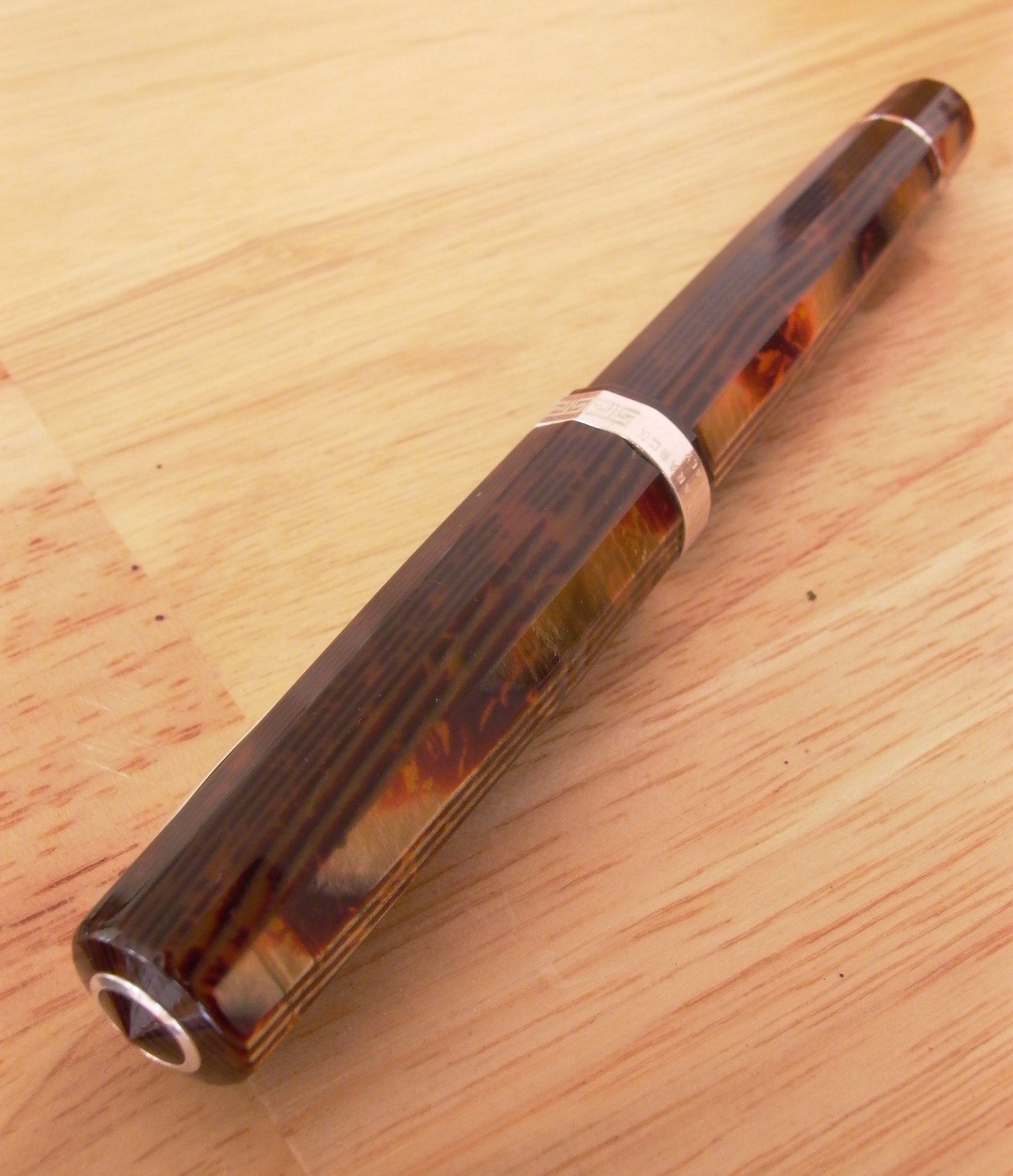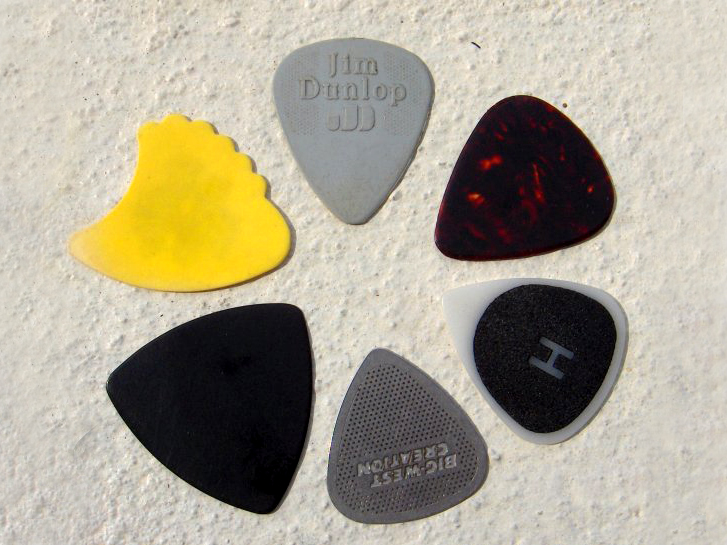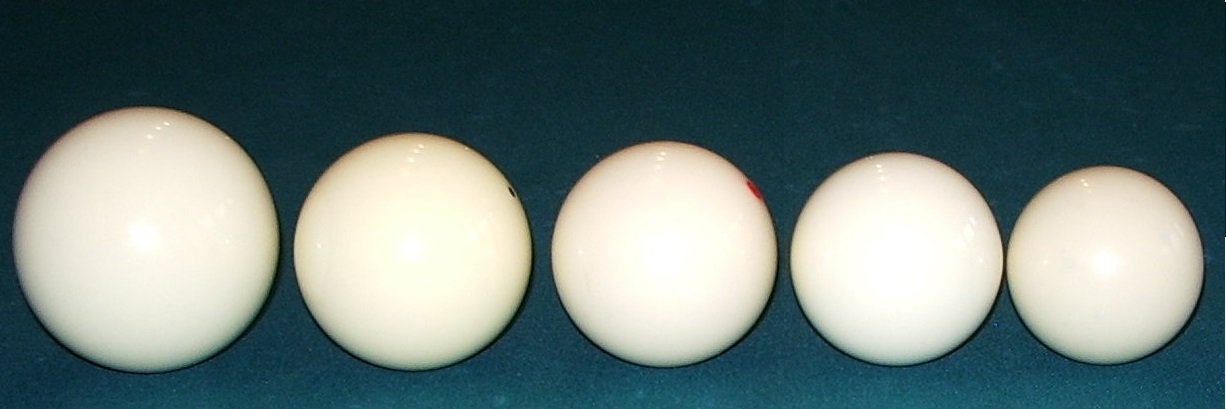|
Celluloid
Celluloids are a class of materials produced by mixing nitrocellulose and camphor, often with added dyes and other agents. Once much more common for its use as photographic film before the advent of safer methods, celluloid's common present-day uses are for manufacturing table tennis balls, musical instruments, combs, office equipment, fountain pen bodies, and guitar picks. History Nitrocellulose Nitrocellulose-based plastics slightly predate celluloid. Collodion, invented in 1848 and used as a wound dressing and an emulsion for photographic plates, is dried to a celluloid like film. Alexander Parkes The first celluloid as a bulk material for forming objects was made in 1855 in Birmingham, England, by Alexander Parkes, who was never able to see his invention reach full fruition, after his firm went bankrupt due to scale-up costs. Parkes patented his discovery as Parkesine in 1862 after realising a solid residue remained after evaporation of the solvent from photographic c ... [...More Info...] [...Related Items...] OR: [Wikipedia] [Google] [Baidu] |
John Wesley Hyatt
John Wesley Hyatt (November 28, 1837 – May 10, 1920) was an American inventor. He is known for simplifying the production of celluloid. Hyatt, a Perkin Medal recipient, is included in the National Inventors Hall of Fame. He had nearly 238 patents to his credit, including improvements to sugar cane mills and water filtration devices. Biography Hyatt was born in Starkey, New York, and began working as a printer when he was 16. Later, he invented a simpler celluloid production process, receiving several hundred patents. Among the most well-known of his inventions was that of a substitute for ivory to produce billiard balls. An award of $10,000 had been instituted by Michael Phelan in 1863 due to the cost of ivory and concerns on its shortage. Aided by his brother Isaiah, Hyatt experimented with Parkesine, a hardened form of nitrocellulose. Parkesine had been invented by the Englishman Alexander Parkes in 1862, and is considered the first true plastic, although it was not a ... [...More Info...] [...Related Items...] OR: [Wikipedia] [Google] [Baidu] |
Guitar Pick
A guitar pick (American English) is a plectrum used for guitars. Picks are generally made of one uniform material, such as some kind of plastic (nylon, Delrin, celluloid), rubber, felt, Tortoiseshell material, tortoiseshell, wood, metal, glass, tagua, thermosetting plastic or stone. They are often shaped in an acute isosceles triangle with the two equal corners rounded and the third corner less rounded. They are used to strum Guitar chord, chords or to sound individual notes on a guitar. In British English, guitar picks are referred to as ''plectra'', reserving the term ''pick'' to identify the difference between this and finger picks. History Musicians have used plectra to play stringed instruments for thousands of years.Hoover, ''pp. 11-12''. Quill, Feather quills were likely the first standardized plectra and became widely used until the late 19th century. At that point, the shift towards what became the superior plectrum material took place; the outer shell casing of a ... [...More Info...] [...Related Items...] OR: [Wikipedia] [Google] [Baidu] |
John Carbutt
John Carbutt (December 2, 1832– July 26, 1905) was a photographic pioneer, stereo card publisher, and photographic entrepreneur. He came to be the first to use celluloid for photographic film and to market dry-plate glass negatives. He was born in Sheffield, England on 2 December 1832. He moved to Chicago in 1853. In 1866, as the official photographer for the Union Pacific Railroad, he produced the series of stereographic cards titled ''Rail Road Excursion to the 100th Meridian.'' The series celebrated the crossing of the border between the western and eastern United States in October 1866 during the construction of the transcontinental railroad.Micah MessenheimerCamera and Locomotive: Two Tracks Across the Continent ''Library of Congress Prints and Photographs Division'' Carbutt founded the Keystone Dry Plate Works in 1879 and was the first to develop sheets of celluloid coated with photographic emulsion for making celluloid film in 1888. Carbutt sliced thin plates from a ... [...More Info...] [...Related Items...] OR: [Wikipedia] [Google] [Baidu] |
Fountain Pen
A fountain pen is a writing instrument that uses a metal nib (pen), nib to apply Fountain pen ink, water-based ink, or special pigment ink—suitable for fountain pens—to paper. It is distinguished from earlier dip pens by using an internal reservoir to hold ink, eliminating the need to repeatedly dip the pen in an inkwell during use. The pen draws ink from the reservoir through a feed to the nib and deposits the ink on paper via a combination of gravity and capillary action. Filling the reservoir with ink may be achieved manually, via the use of an eyedropper or syringe, or via an internal filling mechanism that creates suction (for example, through a piston mechanism) or a vacuum to transfer ink directly through the nib into the reservoir. Some pens employ removable reservoirs in the form of pre-filled ink cartridges. History Early prototypes of reservoir pens According to Qadi al-Nu'man al-Tamimi () in his ''Kitab al-Majalis wa 'l-musayarat'', the Fatimid caliph Al-Mu'izz ... [...More Info...] [...Related Items...] OR: [Wikipedia] [Google] [Baidu] |
Nitrocellulose
Nitrocellulose (also known as cellulose nitrate, flash paper, flash cotton, guncotton, pyroxylin and flash string, depending on form) is a highly flammable compound formed by nitrating cellulose through exposure to a mixture of nitric acid and sulfuric acid. One of its first major uses was as guncotton, a replacement for gunpowder as propellant in firearms. It was also used to replace gunpowder as a low-order explosive in mining and other applications. In the form of collodion, it was also a critical component in an early photographic emulsion, the use of which revolutionized photography in the 1860s. In the 20th century, it was adapted to automobile lacquer and adhesives. Production The process uses a mixture of nitric acid and sulfuric acid to convert cellulose into nitrocellulose. The quality of the cellulose is important. Hemicellulose, lignin, pentosans, and mineral salts give inferior nitrocelluloses. In organic chemistry, nitrocellulose is a nitrate ester, not a ... [...More Info...] [...Related Items...] OR: [Wikipedia] [Google] [Baidu] |
Keystone Dry Plate Works
The Keystone Dry Plate and Film Works was founded by John Carbutt in 1879 in Philadelphia, and its 113 Berkley Street location was constructed in Germantown in 1884. The factory became the location for his pioneering work in new photographic technologies, including improved glass plate photography, x-ray imaging, the first 35 mm celluloid film, and very early color photography procedures. Carbutt developed the first gelatine-bromide dry plates (1879), the first orthochromatic dry plates (1886) and the first celluloid dry plates(1888) in this location. He produced the first 35mm film here and sold it to Thomas Edison. In 1888, he introduced the less than a decade-old Edison light bulb to increase productivity in his factory, and in 1896, Carbutt began to manufacture the first x-ray plates for commercial use. In his later years, Carbutt experimented with color photography. John Carbutt died in 1905. In the early 20th century the factory was bought by Defender Photo Supply, ba ... [...More Info...] [...Related Items...] OR: [Wikipedia] [Google] [Baidu] |
Cellulose
Cellulose is an organic compound with the chemical formula, formula , a polysaccharide consisting of a linear chain of several hundred to many thousands of glycosidic bond, β(1→4) linked glucose, D-glucose units. Cellulose is an important structural component of the primary cell wall of green plants, many forms of algae and the oomycetes. Some species of bacteria secrete it to form biofilms. Cellulose is the most abundant biopolymer, organic polymer on Earth. The cellulose content of cotton fibre is 90%, that of wood is 40–50%, and that of dried hemp is approximately 57%. Cellulose is mainly used to produce paperboard and paper. Smaller quantities are converted into a wide variety of derivative products such as cellophane and rayon. Conversion of cellulose from energy crops into biofuels such as cellulosic ethanol is under development as a renewable fuel source. Cellulose for industrial use is mainly obtained from wood pulp and cotton. Cellulose is also greatly affected by ... [...More Info...] [...Related Items...] OR: [Wikipedia] [Google] [Baidu] |
Albany Billiard Ball Company
The Albany Billiard Ball Company was an American manufacturer of Cue sports, billiard s based in Albany, New York. The company was founded in 1868, manufacturing for over 100 years, before going out of business in 1986. History In the 1860s, John Wesley Hyatt of Albany, New York acquired British chemist Alexander Parkes's 1855 patent for Parkesine, an early polymer, made of nitrocellulose, oil and various solvents. Parkes's own attempt to build a business around the new material, the first industrial plastic, had failed by 1868. Hyatt began experimenting with cellulose nitrate with the intention of manufacturing billiard balls, which until that time were principally made from ivory (cheaper balls were made of clay or wood). Using cloth, ivory dust, and shellac, Hyatt devised a method of covering billiard balls with the addition of collodion in 1868. To manufacture the product, Hyatt formed the ''Albany Billiard Ball Company'', in Albany, New York's South End in 1868, with assist ... [...More Info...] [...Related Items...] OR: [Wikipedia] [Google] [Baidu] |
Billiard Ball
A billiard ball is a small, hard ball used in cue sports, such as carom billiards, pool, and snooker. The number, type, diameter, color, and pattern of the balls differ depending upon the specific game being played. Various particular ball properties such as hardness, friction coefficient, and resilience are important to accuracy. History Early balls were made of various materials, including wood and clay (the latter remaining in use well into the 20th century). Although affordable ox-bone balls were in common use in Europe, elephant ivory was favored since at least 1627 until the early 20th century; the earliest known written reference to ivory billiard balls is in the 1588 inventory of Thomas Howard, 4th Duke of Norfolk. This is a revised version of ''The Story of Billiards and Snooker'', 1979. Dyed and numbered balls appeared around the early 1770s. By the mid-19th century, elephants were being slaughtered for their ivory at an alarming rate, just to keep up with the dem ... [...More Info...] [...Related Items...] OR: [Wikipedia] [Google] [Baidu] |
Kinetoscope
The Kinetoscope is an early motion picture exhibition device, designed for films to be viewed by one person at a time through a peephole viewer window. The Kinetoscope was not a movie projector, but it introduced the basic approach that would become the standard for all cinematic projection before the advent of video: it created the illusion of movement by conveying a strip of perforated film bearing sequential images over a light source with a high-speed shutter. First described in conceptual terms by U.S. inventor Thomas Edison in 1888, it was largely developed by his employee William Kennedy Laurie Dickson between 1889 and 1892. Dickson and his team at the Edison lab in New Jersey also devised the Kinetograph, an innovative motion picture camera with rapid intermittent, or stop-and-go, film movement, to photograph movies for in-house experiments and, eventually, commercial Kinetoscope presentations. A Kinetoscope prototype was first semipublicly demonstrated to members ... [...More Info...] [...Related Items...] OR: [Wikipedia] [Google] [Baidu] |
Table Tennis
Table tennis (also known as ping-pong) is a racket sport derived from tennis but distinguished by its playing surface being atop a stationary table, rather than the Tennis court, court on which players stand. Either individually or in teams of two, players take alternating turns returning a light, hollow ball over the table's net onto the opposing half of the court using small table tennis racket, rackets until they fail to do so, which results in a point for the opponent. Play is fast, requiring quick reaction and constant attention, and is characterized by an emphasis on spin, which can affect the ball's trajectory more than in other ball sports. Owed to its small minimum playing area, its ability to be played indoors in all climates, and relative accessibility of equipment, table tennis is enjoyed worldwide not just as a competitive sport, but as a common recreational pastime among players of all levels and ages. Table tennis has been an Table tennis at the Summer Olympics, ... [...More Info...] [...Related Items...] OR: [Wikipedia] [Google] [Baidu] |
Camphor
Camphor () is a waxy, colorless solid with a strong aroma. It is classified as a terpenoid and a cyclic ketone. It is found in the wood of the camphor laurel (''Cinnamomum camphora''), a large evergreen tree found in East Asia; and in the kapur tree (Dryobalanops, ''Dryobalanops'' sp.), a tall timber tree from South East Asia. It also occurs in some other related trees in the Lauraceae, laurel family, notably ''Ocotea usambarensis''. Rosemary leaves (''Rosmarinus officinalis'') contain 0.05 to 0.5% camphor, while camphorweed (''Heterotheca'') contains some 5%. A major source of camphor in Asia is Ocimum kilimandscharicum, camphor basil (the parent of African blue basil). Camphor can also be synthetically produced from oil of turpentine. The compound is Chirality (chemistry), chiral, existing in two possible enantiomers as shown in the structural diagrams. The structure on the left is the naturally occurring (+)-camphor ((1''R'',4''R'')-bornan-2-one), while its mirror image show ... [...More Info...] [...Related Items...] OR: [Wikipedia] [Google] [Baidu] |










